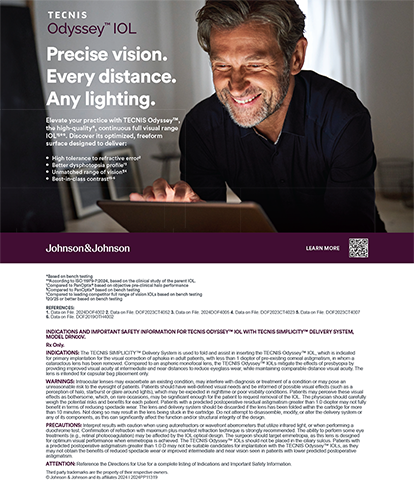Most ophthalmologists have long glossed over the subject of meibomian gland dysfunction (MGD), despite the fact that its symptoms are directly correlated to some of the most common ocular complaints. In fact, MGD is now recognized as one of the most important causes of dry eye syndrome (DES) or ocular surface dysfunction. In my opinion, the latter term better encompasses the multiple interrelated entities such as DES and blepharitis. A new subclass of MGD might be identified as “nonobvious MGD”; there is no overt inflammation or pathology, yet the glands may not function (Figure 1). Nonobvious MGD may delay accurate diagnosis.
Of course, patients affected by DES and MGD include those interested in cataract and refractive surgery. The significant impact that DES can have on surgical outcomes is well accepted. It stands to reason that MGD is equally important. Common sense dictates that diagnosing and managing this disease preoperatively should enhance the postoperative course.
DIAGNOSIS
The LipiView (TearScience, Inc.) is an ocular surface interferometer. The device images and analyzes the tear film in a 5-minute, noninvasive procedure. By looking at the color map produced by the LipiView, the physician can assess the quality of the tear film's lipid component and use the information to guide clinical decisions. Moreover, this map can help convey to patients what the clinician has determined about the tear film and how it correlates to their symptoms.
TREATMENT
Background
Historically, the treatment of MGD has attempted to facilitate the outflow of meibum or secretions from the ducts of the meibomian gland. Research has shown that, in these dysfunctional states, the physicochemical makeup of the secretions is altered, leading to changes in viscosity and a predisposition to obstruction.1 Chronic blockage often results in histological changes to the ducts such as narrowed lumens, further enhancing the likelihood of obstruction.
Until recently, the only invasive option for treatment was to probe the meibomian gland orifices. Disadvantages of this approach are that it can be time intensive for the practitioner and that it causes some degree of discomfort for patients.
In July 2011, the FDA cleared the LipiFlow Thermal Pulsation System (TearScience, Inc.). My experience with this device began during its initial clinical trials. The concept is simple yet brilliant. Developed by Donald Korb, OD, the premise behind LipiFlow is this: no matter how well clinicians instruct patients in using warm compresses and lid scrubs, even those who are compliant find it nearly impossible to achieve a sufficient temperature and pressure at the base of the meibomian gland to effect any long-term change.
LipiFlow is a 12-minute, bilateral treatment that uses a specially designed eyelid warmer and eyecup (Figure 2). It achieves a temperature high enough to liquefy the contents of the meibomian gland, facilitate secretions from that gland, and increase the likelihood that it can resume normal function. The eyecup is designed to vault over the cornea, and the heating element is confined to deliver heat only to the tarsal conjunctiva. As heat reaches the base of the glands, pulsation is achieved by means of a bladder that compresses the eyelids. This action has several purposes. First, it transiently increases blood flow to the tissue surrounding the glands, thus increasing the efficiency of heat transfer. Second, the pulsatile action mechanically evacuates the gland's heated and liquefied contents, thus alleviating the obstruction. Based on my personal experience with more than 35 patients, the procedure produces considerably less eyelid pain/discomfort compared with manual expression techniques.
Results
In an open-label, randomized, controlled, multicenter trial, the LipiFlow system was compared to the iHeat warm compress system (Advanced Vision Research) for the treatment of MGD. Nine centers participated in this study and enrolled 278 eyes (139 subjects). These patients were randomized to receive either the LipiFlow treatment (n = 138 eyes in 69 subjects) or the iHeat warm compresses (n = 140 eyes in 70 control subjects).
At 2 weeks, the control group stopped warm compress therapy and received LipiFlow treatment. For all parameters measured (ie, meibomian gland obstruction scores, tear breakup time, Standard Patient Evaluation for Eye Dryness, and Ocular Surface Disease Index), the treated group showed significant improvements compared with the control group. Moreover, after the control group crossed over to the treatment arm of the study, all of their measured parameters increased significantly.
Aside from three eyes (out of 278) that experienced mild pain and one eye that had conjunctival injection, there were no adverse events, including no changes in vision or IOP. In addition, although this was a 4-week study, other ongoing research with the LipiFlow system indicates that its effects may persist for more than 1 year. The final results of these long-term studies, however, will not be available for some time.
SURGICAL IMPLICATIONS
Although I have not used the LipiView or LipiFlow in the setting of cataract or refractive surgery, I can envision incorporating the former into the preoperative evaluation of patients. Comparing the images obtained with this device over time, along with evaluative gland expression, would also allow the clinician to assess the efficacy of therapy.
MGD and DES are major determinants of final visual acuity, the overall postoperative course, and patients' perceptions of the success of cataract and refractive surgery. Treating patients diagnosed with significant tear film dysfunction or MGD should therefore promote better surgical outcomes.
Portions of this article are adapted with permission from an article by Dr. Majmudar that appeared in the November/December 2011 edition of Advanced Ocular Care.
Parag A. Majmudar, MD, is an associate professor, Cornea Service, Rush University Medical Center, Chicago Cornea Consultants, Ltd. He is a consultant to and has received research funding from TearScience, Inc. Dr. Majmudar may be reached at (847) 822-5900; pamajmudar@chicagocornea.com.


